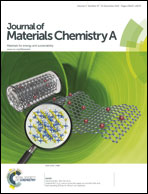A multifunctional Eu MOF as a fluorescent pH sensor and exhibiting highly solvent-dependent adsorption and degradation of rhodamine B†
Abstract
Due to their tunable structure and porosity, metal–organic frameworks have provided a new platform for fluorescence sensing and adsorption/separation of gas or organic molecules. Many studies have focused on sensing metal ions, anions, or organic molecules through fluorescence quenching or enhancement of MOFs, but studies on pH-fluorescence sensors are seldom reported. Furthermore, highly solvent-dependent adsorption and degradation of dye molecules based on functional MOFs has not been explored to date. In this study, we describe a multifunctional Eu MOF, [H3O][Eu3(HBPTC)2(BPTC)(H2O)2]·4DMA (UPC-5, UPC = China University of Petroleum [East China]) based on a tetracarboxylate ligand. The luminescence intensity of UPC-5 is strongly correlated with the pH value in the pH range from 7.5 to 10.0, and a linear relationship between pH value and fluorescent intensity is observed. Another attractive property of UPC-5 is that its Li-exchanged form, Li-UPC-5, possesses solvent-dependent adsorption and degradation of rhodamine B. The highly efficient degradation or decolorization of rhodamine B with long-term stability and activity gives Li-UPC-5 a potential advantage in treating rhodamine B pollution.


 Please wait while we load your content...
Please wait while we load your content...